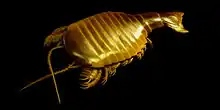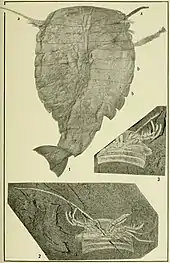Sidneyia
Sidneyia is an extinct arthropod known from fossils found from the Early Cambrian-age Maotianshan Shales[1] to the Mid Cambrian Burgess Shale formation of British Columbia. 144 specimens of Sidneyia are known from the Greater Phyllopod bed, where they comprise 0.27% of the community.[2]
| Sidneyia | |
|---|---|
 | |
| Reconstruction of Sidneyia | |
| Scientific classification | |
| Kingdom: | Animalia |
| Phylum: | Arthropoda |
| (unranked): | †Artiopoda |
| (unranked): | †Vicissicaudata |
| Genus: | †Sidneyia Walcott, 1911 |
| Type species | |
| †Sidneyia inexpectans Walcott, 1911 | |
| Species | |
| |
General description

Sidneyia ranged from 2 to 5 inches (51 to 127 mm) in length and is one of the largest arthropods found at the site. It is thought to have been a benthic carnivore and scavenger that walked along the sea floor in search of hard-shelled prey. Gut contents have revealed that Sidneyia fed largely on small trilobites, as well as on brachiopods, hyoliths and small arthropods. The gut was narrow, but widens posteriorly to form a pocket where digestion presumably took place. The retention of feces likely indicates infrequent feeding[3] Its exquisitely preserved gnathobases resemble those of Limulus, and were probably used to crush prey.[4]
Sidneyia was discovered in 1910 during the first day of Charles Walcott's exploration of the Burgess Shale. He named it after his elder son, Sidney, who had helped to locate the site and collect the specimen. The species name, Sidneyia inexpectans, is derived from the meaning of "Sidney's surprise".
Sidneyia sinica was named in 2002 from a specimen found in the Maotianshan Shales.[1]
About 200 specimens have been documented.
References
- Zhang, Xingliang; Han, Jian; Shu, Degan (27 Nov 2008). "New occurrence of the Burgess Shale arthropod Sidneyia in the Early Cambrian Chengjiang Lagerstätte (South China), and revision of the arthropod Urokodia". Alcheringa: An Australasian Journal of Palaeontology. 26: 1–8. doi:10.1080/03115510208619239. S2CID 129442308.
- Caron, Jean-Bernard; Jackson, Donald A. (October 2006). "Taphonomy of the Greater Phyllopod Bed community, Burgess Shale". PALAIOS. 21 (5): 451–65. Bibcode:2006Palai..21..451C. doi:10.2110/palo.2003.P05-070R. JSTOR 20173022. S2CID 53646959.
- Zacaï, Axelle; Vannier, Jean; Lerosey-Aubril, Rudy (March 2016). "Reconstructing the diet of a 505-million-year-old arthropod: Sidneyia inexpectans from the Burgess Shale fauna" (PDF). Arthropod Structure & Development. 45 (2): 200–220. doi:10.1016/j.asd.2015.09.003. PMID 26410799.
- Bicknell, Russell D.C; Paterson, John R; Caron, Jean-Bernard; Skovsted, Christian B (2017). "The gnathobasic spine microstructure of recent and Silurian chelicerates and the Cambrian artiopodan Sidneyia : Functional and evolutionary implications". Arthropod Structure & Development. 47 (1): 12–24. doi:10.1016/j.asd.2017.12.001. PMID 29221679.
External links
- "Sidneyia inexpectans". Burgess Shale Fossil Gallery. Virtual Museum of Canada. 2011.
Further reading
- C. L. Bruton (1981). "The arthropod Sidneyia inexpectans, Middle Cambrian, Burgess Shale, British Columbia". Philosophical Transactions of the Royal Society B: Biological Sciences. 295 (1079): 619–653. Bibcode:1981RSPTB.295..619B. doi:10.1098/rstb.1981.0164.
